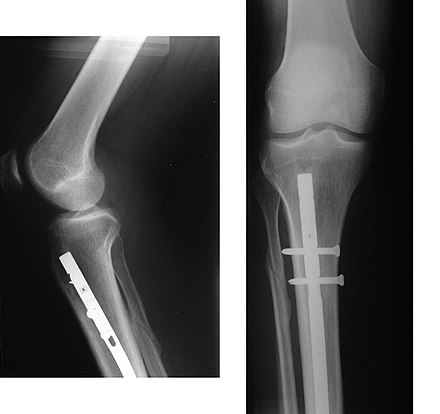Bone Fracture
A bone fracture (abbreviated FRX or Fx) is a medical condition that involves a partial or complete break in the continuity of any bone in the body. Severe cases may result in the bone shattering into several fragments, known as a comminuted fracture.
Fractures can result from high-force impacts, stress, or minimal trauma due to underlying medical conditions such as osteoporosis, bone cancer, or osteogenesis imperfecta.
Signs and Symptoms
Bone fractures are painful due to several reasons, even though bone tissue lacks pain receptors. Pain arises from the breaking of the periosteum and endosteum, both of which contain pain receptors, and from oedema and hematoma in nearby soft tissues caused by ruptured bone marrow. Involuntary muscle spasms can also attempt to stabilise bone fragments, contributing to pain. Damage to adjacent structures such as nerves, muscles, or blood vessels may lead to additional symptoms.
Complications
Complications of fractures can be immediate, early, or late. Immediate complications include hypovolaemic shock and injury to major vessels, muscles, tendons, joints, and viscera. Early complications may include acute respiratory distress syndrome (ARDS), fat embolism syndrome, deep vein thrombosis, and sepsis in open fractures. Late complications include non-union, malunion, avascular necrosis, and osteomyelitis.

Pathophysiology
The natural healing process of a bone fracture starts with the formation of a fracture hematoma. Blood clots form between broken fragments, followed by new blood vessels bringing fibroblasts that produce collagen fibres. Over time, the collagen matrix mineralizes and stiffens, transforming into bone. This process involves initial "woven" bone being replaced by mature "lamellar" bone.

Diagnosis
Diagnosis of bone fractures is typically based on patient history and physical examination, confirmed by radiographic imaging such as X-rays. In cases where projectional radiography is insufficient, CT or MRI may be used.

Fractures are classified based on various factors including the mechanism of injury (traumatic or pathologic), soft-tissue involvement (closed or open fractures), displacement, fracture pattern (linear, transverse, oblique, spiral), and anatomical location.

Treatment
Treatment of bone fractures can be either surgical or conservative, with the goal of ensuring the best function of the injured part post-healing. Pain management is very important, with ibuprofen found to be effective in children. Immobilisation with casts or splints helps maintain bone alignment, while surgical methods involve nails, screws, plates, and wires.

Physical therapy exercises are often recommended to help recover physical capacities post-healing. Bone stimulation using electromagnetic or ultrasound waves may also be suggested to reduce healing time for non-union fractures, although evidence supporting this is weak.

Self-assessment MCQs (single best answer)
What is a comminuted fracture?
Which of the following complications is considered an immediate complication of bone fractures?
What is the initial stage of fracture repair?
Which imaging technique is typically used first to confirm a bone fracture?
Which type of fracture is described as a partial break in the bone?
What does the periosteum contain that contributes to pain in bone fractures?
Which of the following is a late complication of bone fractures?
What is the role of fibroblasts in the fracture healing process?
Which of the following surgical methods is used to treat bone fractures?
Which of the following statements is true regarding bone pain in fractures?
Dentaljuce
Dentaljuce provides Enhanced Continuing Professional Development (CPD) with GDC-approved Certificates for dental professionals worldwide.
Founded in 2009 by the award-winning Masters team from the School of Dentistry at the University of Birmingham, Dentaljuce has established itself as the leading platform for online CPD.
With over 100 high-quality online courses available for a single annual membership fee, Dentaljuce offers comprehensive e-learning designed for busy dental professionals.
The courses cover a complete range of topics, from clinical skills to patient communication, and are suitable for dentists, nurses, hygienists, therapists, students, and practice managers.
Dentaljuce features Dr. Aiden, a dentally trained AI-powered personal tutor available 24/7 to assist with queries and provide guidance through complex topics, enhancing the learning experience.
Check out our range of courses, or sign up now!


